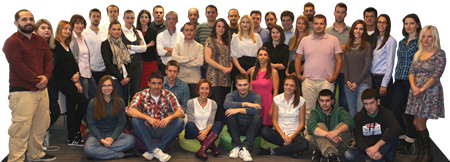Mathematics: The Man-Made Universe - Sherman K Stein
| Cena: |
990 din
(Predmet je prodat)
|
| Stanje: | Polovan sa vidljivim znacima korišćenja |
| Garancija: | Ne |
| Isporuka: | Pošta CC paket (Pošta) Post Express |
| Plaćanje: | Tekući račun (pre slanja) |
| Grad: |
Novi Sad, Novi Sad |
ISBN: Ostalo
Godina izdanja: 1999
Autor: Domaći
Jezik: Engleski
Oblast: Matematika
U prihvatljivom stanju (pečat, zaprljani rubovi knjižnog bloka)
Unabridged Dover (1999) republication of the third edition as published by McGraw-Hill, Inc., New York, 1994. 592pp. 6& x 9%. Paperbound.
This highly readable volume covers a vast array of subjects, including number theory, topology, set theory, geometry, algebra, and analysis.
Anyone can appreciate the beauty, depth, and vitality of mathematics with the help of this highly readable text, specially developed from a college course designed to appeal to students in a variety of fields. Readers with little mathematical background are exposed to a broad range of subjects chosen from number theory, topology, set theory, geometry, algebra, and analysis.
Starting with a survey of questions on weight, the text discusses the primes, the fundamental theorem of arithmetic, rationals and irrationals, tiling, tiling and electricity, probability, infinite sets, and many other topics. Each subject illustrates a significant idea and lends itself easily to experiments and problems. Useful appendices offer an overview of the basic ideas of arithmetic, the rudiments of algebra, suggestions on teaching mathematics, and much more, including answers and comments for selected exercises.
Sherman Kopald Stein is an American mathematician and an author of mathematics textbooks. He is a professor emeritus at the University of California, Davis. His writings have won the Lester R. Ford Award and the Beckenbach Book Prize.
Contents
Map x
Guide xi Preface xili
1. Questions on Weighing 1
Weighing with a two-pan balance and two measures — Problems raised— Their algebraic phrasing
2. The Primes 13
The Greek Prime-manufacturing Machine—Gaps between primes—
Average gap and 1/1 + 1/2 + 1/3 + • • • + 1/N— Twin primes
3. The Fundamental Theorem of Arithmetic 35
Special natural numbers —Every special number is prime—“Unique factorization’` and “every prime is special” compared—Euclidean algorithm
— Every prime number is special — The concealed theorem
4. Rationale and Irrationals 56
The Pythagorean Theorem —The square root of 2—Natural numbers whose square root is irrational — Rational numbers and repeating decimals
5. Tiling 77
The rationals and tiling a rectangle with equal squares —Tiles of various shapes —Use of algebra - Filling a box with cubes
6. Tiling and Electricity 99
Current—The role of the rationals —Application to tiling—Isomorphic structures
7. The Highway Inspector and the Salesman 123
A problem in topology—Routes passing once over each section of highway
— Routes passing once through each town
8. Memory Wheels 141
A problem raised by an ancient word—Overlapping n-tuplets —Solution— History and applications
9. The Representation of Numbers 156
Representing natural numbers—The decimal system (base ten)—Base two— Base three-Representing numbers between 0 and 1—Arithmetic in base three—The Egyptian system—The decimal system and the metric system
10. Congruence 192
Two integers congruent modulo a natural number—Relation to earlier chapters—Congruence and remainders—Properties of congruence—Casting out nines—Theorems for later use
11. Strange Algebras 218
Miniature algebras—Tables satisfying rules—Commutative and idempotent tables—Associativity and parentheses — Groups
12. Orthogonal Tables 243
Problem of the 36 officers —Some experiments —A conjecture generalized — Its fate—Tournaments —Application to magic squares
13. Chance 273
Probability—Dice—The multiplication rule—The addition rule—The subtraction rule—Roulette—Expectation —Odds —Baseball —Risk in making decisions
14. The Fifteen Puzzle 316
The Fifteen puzzle—A problem in switching cords —Even and odd arrangements—Explanation of the Fifteen puzzle—Clockwise and counterclockwise
15. Map Coloring 336
The two-color theorem —Two three-color theorems—The five-color theorem — The four-color conjecture
16. Types of Numbers 369
Equations —Roots—Arithmetic of polynomials—Algebraic and transcendental numbers—Root r and factor X — r— Complex numbers—Complex numbers applied to alternating current—The limits of number systems
17. Construction by Straightedge and Compass 413
Bisection of line segment—Bisection of angle—Trisection of line segment— Trisection of 90° angle—Construction of regular pentagon—Impossibility of constructing regular 9-gon and trisecting 60° angle
18. Infinite Sets 440
A conversation from the year 1638—Sets and one-to-one correspondence— Contrast of the finite with the infinite—Three letters of Cantor—Cantor’s Theorem — Existence of transcendentals
19. A General View 471
The branches of mathematics—Topology and set theory as geometries—
The four “shadow” geometries—Combinatorics —Algebra—Analysis— Probability—Types of proof—Cohen’s theorem—Truth and proof—Godel’s theorem
APPENDICES
A. Review of Arithmetic 497
A quick tour of the basic ideas of arithmetic
B. Writing Mathematics 521
Some words of advice and caution
C. The Rudiments of Algebra 524
A review of algebra, which is reduced to eleven rules
D. Teaching Mathematics 541
Suggestions to prospective and practicing teachers
E. The Geometric and Harmonic Series 544
Their properties —Application of geometric series to probability
F. Space of any Dimension 556
Definition of space of any dimension
G. Update 561
Answers and Comments for Selected Exercises 563
Index 571
L_I_Č_N_O______P_R_E_U_Z_I_M_A_NJ_E_:
Za kupovine ukupne vrednosti preko 2.000 dinara moguće lično preuzimanje u Cara Dušana u Novom Sadu. Ako je za pojedinačnu knjigu navedena samo opcija Pošta, lično preuzimanje samo te knjige nije moguće. U Novom Sadu moguća je lična dostava i plaćanje preko službe Eko-kurir (cena je 250-300 din).
STANJE KNJIGE:
Knjiga koju dobijate je ona koja je na slici. Ukoliko nije naznačeno da je knjiga nova ili nekorišćena, ponekad se desi da na predlistu stoji potpis, posveta ili pečat i da to nije navedeno u opisu. Ako vam takve stvari smetaju, pitajte me pre kupovine da proverim.
KOMUNIKACIJA:
Komunikacija ide isključivo preko Kupindo poruka, ne telefonom. Budite normalni.
POPUSTI, CENKANJE I SL.:
Cena je ta koja piše, molim vas da mi ne šaljete pitanja o poslednjoj i zadnjoj ceni niti svoje kontraponude.
SLANJE:
Knjige šaljem kao tiskovinu ili CC paket nakon uplate na račun. Pakujem ih bezbedno i pažljivo, dobijate ih u stanju u kojem su poslate. Poštarina za jednu pošiljku obično iznosi od 190 do 260 din, u zavisnosti od težine. To je poštarina za tiskovinu, CC paket je skuplji, post ekspres je najskuplji. Za četiri i više pojedinačno kupljenih knjiga (u to ne spadaju kompleti) ja snosim troškove poštarine. Potrebno je da uplatite/preuzmete knjigu u propisanom roku od 7 dana.
SUSEDNE ZEMLJE I INOSTRANSTVO:
Poštarina je za jednu knjigu visoka i okvirno se kreće od 10-15 eur za prvu i oko 7 eura za svaku dodatnu knjigu. Postoji mogućnost znatno isplativijeg slanja za teže pakete. Uplate PayPalom (+10%), direktno na devizni račun, Western Union ili Moneygram. Najbolje je da pre kupovine pitate koliki su troškovi dostave, jer su često veći od cene same knjige.
INTERNATIONAL ORDERS:
I will send abroad. For your calculation, one hundred dinars roughly equals $1. Please register here:
https://www.limundo.com/Registracija/Kupindo
and then PM me on the link below for postage costs (they usually start at around 15 euro for the first book and 7 euro for each additional one)
https://www.kupindo.com/Clan/ndi/PostaviPitanje
MOJA PONUDA:
Nove knjige postavljam gotovo svaki dan. Možete ih pratiti na ovom linku http://www.limundo.com/Clan/ndi (pritisnite dugme `Prati`)
¤¤¤¤¤¤¤¤¤¤¤¤¤¤¤¤¤¤¤¤¤¤¤¤¤¤¤¤¤¤¤¤¤¤¤¤¤¤¤¤¤¤¤¤¤¤¤¤¤¤¤¤¤¤¤¤¤¤¤¤¤¤¤¤¤¤¤¤¤¤¤¤¤¤¤¤¤¤¤¤¤¤¤¤
Predmet: 79170677







